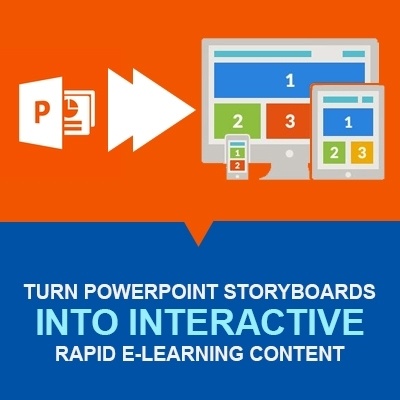How To Spice Up Your Storyboard By Following These Simple 3 Steps
On your next assignment, consider spicing up the same old recipe with a few fresh ideas.
1. Use The Revised Bloom’s Taxonomy To Write Objectives
Before we dive into eLearning methods, let’s back up the learning delivery truck just a bit and figure out what we want learners to do differently (or better) than they are doing now.
Like most Instructional Designers, you probably classify training goals and objectives using Bloom’s Cognitive Taxonomy, but did you know this taxonomy was updated by Anderson and Krathwohl [1]? The revision occurred back in 2001, but somehow many missed the memo.
The revised version defines knowledge across 4 dimensions—factual, conceptual, procedural, and metacognitive—and the levels are now phrased as nouns. For instance, the "knowledge" level from the 1956 version of Bloom’s is now called "remember", and the former "comprehension" level is now called "understand".
If you are not using the revised version of Bloom’s already, reference the updated levels listed below while you craft learning objectives for your next project. Then, you’ll be better able to map your objectives to the proposed eLearning treatments in this article.

2. Select eLearning Treatments That Support Your Objectives
The concept of writing objectives before selecting instructional treatments sounds basic, but sometimes our excitement to ride buzzword trains (like "rapid design" or "agile development") convolutes the process, so it’s worth restating.
The great news is, once your objectives are written, selecting the best eLearning treatment can be a rapid process. Simply, use the outline below as a quick reference tool to identify the best types of eLearning treatments for your objectives.
For instance, if your objective starts with the verb "identify" then it falls under the "remember" level of Bloom’s Taxonomy. According to this outline, an effective eLearning treatment might be a multimedia presentation, labeled graphic interaction, video, software demonstration, interactive process graphic, etc. There are many options available, so you can spice up your storyboard with new and fresh ideas for your learners.
The outline below is merely a starting point; you could add other eLearning treatments to it as you begin to develop more innovative eLearning treatment ideas.
Remember And Understand eLearning Treatments
Sample Objective Verbs:
Identify, relate, list, define, recall, memorize, repeat, record, name, recognize, acquire, classify, describe, discuss, explain, illustrate, give examples, review, paraphrase, interpret
- Multimedia Presentation
Watch a documentary-style video with panning stock photos and graphics, audio narration, and minimal screen text (think History Channel® documentaries). - Labeled Graphics Interaction
Click hotspots on a graphic to populate informational text boxes and/or audio/video. - Video
Watch a video demonstration. - Software Demonstration
Demonstrate software tasks using screenshots or recorded screen video. - Interactive Process Graphic
Design a custom process graphic with click-to-reveals that populate information text boxes and/or video/audio. - Timeline Interaction
Design a timeline with buttons that populate information text boxes and/or video/audio. - Recorded Whiteboard Discussion
Use screen capturing to record a facilitator drawing and explaining a concept graphic on a whiteboard (e.g. WebEx® whiteboard). - Mnemonic
Create a memory device (e.g. acronym) to help learners remember a sequence or list of content. - Knowledge Checks
Multiple choice, multiple select, matching, true/false and drag and drop. - FAQ Interaction
Click-to-reveal commonly asked questions and answers on a given topic.
Apply And Analyze eLearning Treatments
Sample Objective Verbs:
Assess, chart, construct, demonstrate, develop, produce, report, select, use, show, solve, characterize, classify, compare, contrast, correlate, distinguish, differentiate, examine
- Try-It Simulation
The learner is presented with a screen capture with "try-it" prompts, interactions, and feedback. - Case Study
The learner reads a case study (or watches it via video or multiple presentation) and answers a series of multiple choice/multiple select questions that require analytical thinking. - Branching Scenarios
The learner is presented with a scenario and answers a series of questions about how to solve it. The progression of questions varies based on the learner’s response to each question. - Hotspot Examination
The learner clicks a hotspot on a photo or graphic to identify what is wrong, out of place or otherwise different than it should be.
Evaluate And Create eLearning Treatments
Sample Objective Verbs:
Categorize, compose, construct, design, formulate, integrate, invent, produce, rewrite, evaluate, critique, predict, form, reorganize, produce, plan, structure
- Drag And Drop
Drag and drop text or images into categories or into a ranking order. Or, drag and drop them freestyle to create a new concept, process or product. - Whiteboard
Allow learners to design/draw a concept or process map on a whiteboard. Then, have them compare it with a simple concept or process map. Or, invite learners to draw a new concept, product, or process on a whiteboard.
3. Collaborate With Your Production Crew To Discover More Possibilities
Some Instructional Designers storyboard and produce their deliverables; however, if you work with a production crew, involve them in your design discussions. Using their knowledge of multimedia design and production software, they can offer ideas you didn’t realize were possible. Also, they can also warn against treatments that may jeopardize the project timeline before the storyboard is signed off by your primary stakeholder.
Commit To Greater Creativity
Are you ready to broaden your storyboarding horizons? If you are ready to commit to greater creativity, you can begin by:
- Becoming familiar with the revised Bloom’s Taxonomy and writing objectives before selecting design treatments.
- Using the outline in this article to select a variety of eLearning treatments that support your objectives.
- Involving your production crew (if applicable) to generate additional design ideas and explore new possibilities.
References:
- Wilson, L. O. (n.d.). Anderson and Krathwohl - Bloom's Taxonomy Revised









